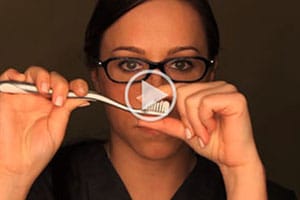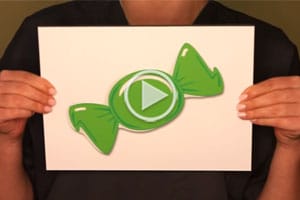The best way to ensure a clean and healthy smile is brushing and flossing. Food particles can accumulate on teeth and in braces, and over time, turn into plaque. The bacteria that results from this accumulation can lead to gum disease, tooth decay and even loss of teeth. To avoid these problems while you are in orthodontic treatment, take special care of your braces, teeth, and gums to ensure you will have the best possible result.
Brushing
Use a toothbrush with soft bristles and a small strip of fluoride toothpaste. When you brush your teeth, move the brush in small, circular motions to reach food particles that may be under your gum line. Hold the toothbrush at an angle and brush slowly and carefully, covering all areas between teeth, between braces and the surface of each tooth. It will take you several minutes to thoroughly brush your teeth. Brush up on the lower teeth, down on the upper teeth and the outside, inside and chewing surface of your front and back teeth. Brush your tongue and the roof of your mouth before you rinse.
Especially during orthodontic treatment, brush your teeth four times daily to avoid the accumulation of food particles in your teeth and braces:
- In the morning after breakfast
- After lunch or right after school
- After supper
- At bedtime
You will need to replace your toothbrush more often due to your appliances. As soon as the bristles start to wear down or fray, replace your toothbrush with a new one. It may be difficult for your toothbrush to reach some areas under your archwire. Do not swallow any toothpaste; rinse your mouth thoroughly with water after you finish brushing. It is important to floss and use an antibacterial mouthwash and fluoride treatment throughout your orthodontic treatment and beyond for optimal oral hygiene.
Flossing
For areas between the teeth that a toothbrush can’t reach, use dental floss to remove food particles and plaque. Flossing takes more time and patience when you are wearing braces, but it is important to floss your teeth every day.
Use the reusable floss threader provided by our office to floss under your archwire daily. Pull a small length of floss from the dispenser through the threader and slide it up and down along the front of each tooth. You will be able to feel when the tooth is clean and hear the squeak of the floss against your clean teeth. Use care around your archwire and do not floss too forcefully around it or put too much pressure on it. After you floss between your archwire and braces, floss between your other teeth and gums.
If you are flossing without the floss threader, pull a small length of floss from the dispenser. Wrap the ends of the floss tightly around your middle fingers. Guide the floss between all teeth to the gum line, pulling out food particles or plaque. Unwrap clean floss from around your fingers as you go, so that you have used the floss from beginning to end when you finish. Floss behind all of your back teeth.
Floss at night to make sure your teeth are clean before you go to bed. When you first begin flossing around your braces, your gums may bleed a little. If the bleeding does not go away after the first few times, inform a staff member at your next appointment.
Cleaning Your Removable Appliance
Brush your removable appliance every day as a part of your regular brushing and flossing schedule. Because food particles and plaque can accumulate on your appliance just as they do on your teeth, soak the appliance daily. Dissolve a Polident, Efferdent or other denture-cleaning tablets in a glass of tap water at room temperature and soak your appliance once every day. Your appliance will taste better, and you will prevent plaque and bacterial accumulation.
Elastics
Elastics are a vital part of treatment and are also contingent upon patient compliance. They add extra pressure to the braces to help move the teeth. Soreness is common for the first week, but gargling with salt water can help take away some of the tenderness.
Worn at all times (excluding eating and brushing your teeth), elastics should be replaced with fresh ones immediately after mealtime or brushing. They come in various sizes as they are each used for a specific purpose. We will provide you with the appropriate size.
It is important to wear them consistently or treatment setbacks may occur. Wearing elastics part-time will NOT move your teeth, but it does guarantee that they remain constantly sore!
Diet
For most situations, common sense will tell you what to avoid. Hard foods, sticky foods, and foods high in sugar must be avoided. Hard foods can break or damage wires and brackets. Sticky foods can get caught between brackets and wires. Minimize sugary foods; they cause tooth decay and related problems. Nail biting, pencil, and pen chewing and chewing on foreign objects should be avoided.

